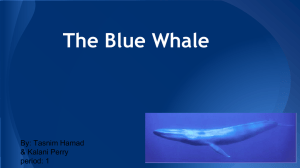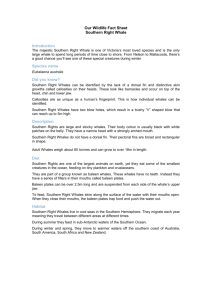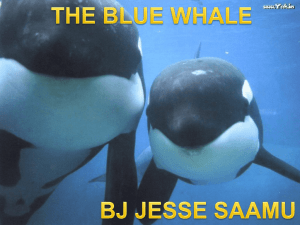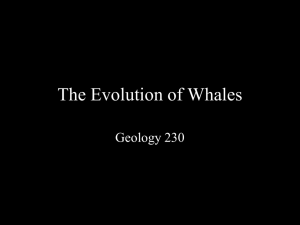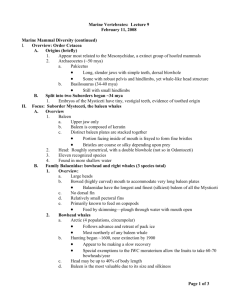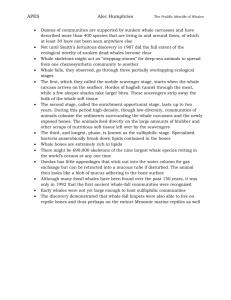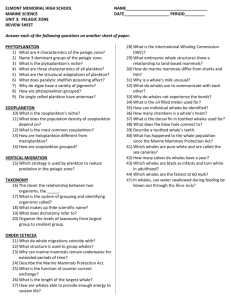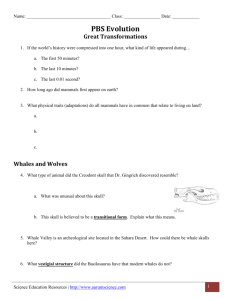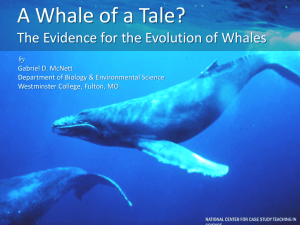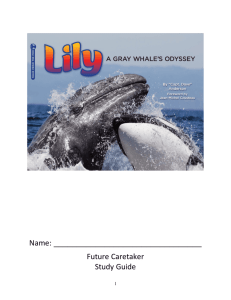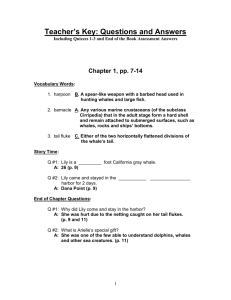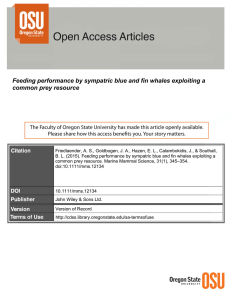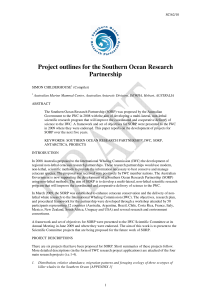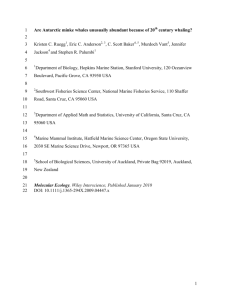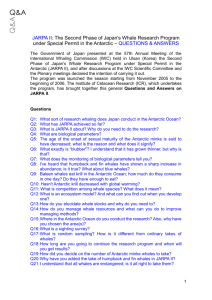Blue whale (accessible version) - Department of Environment, Land
advertisement
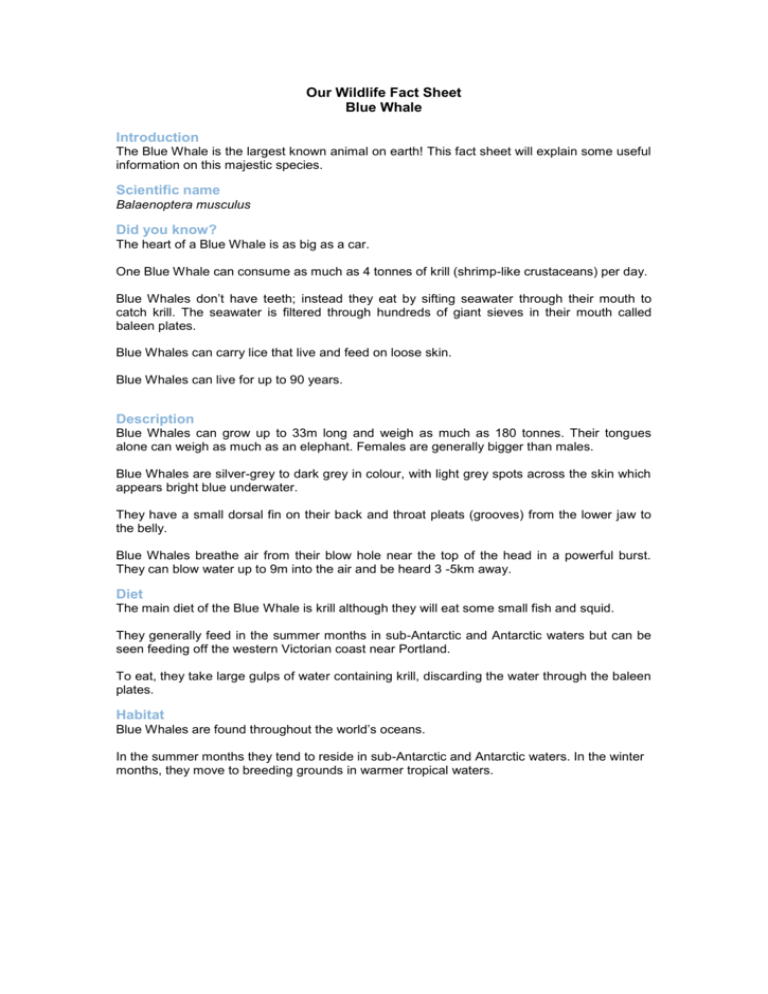
Our Wildlife Fact Sheet Blue Whale Introduction The Blue Whale is the largest known animal on earth! This fact sheet will explain some useful information on this majestic species. Scientific name Balaenoptera musculus Did you know? The heart of a Blue Whale is as big as a car. One Blue Whale can consume as much as 4 tonnes of krill (shrimp-like crustaceans) per day. Blue Whales don’t have teeth; instead they eat by sifting seawater through their mouth to catch krill. The seawater is filtered through hundreds of giant sieves in their mouth called baleen plates. Blue Whales can carry lice that live and feed on loose skin. Blue Whales can live for up to 90 years. Description Blue Whales can grow up to 33m long and weigh as much as 180 tonnes. Their tongues alone can weigh as much as an elephant. Females are generally bigger than males. Blue Whales are silver-grey to dark grey in colour, with light grey spots across the skin which appears bright blue underwater. They have a small dorsal fin on their back and throat pleats (grooves) from the lower jaw to the belly. Blue Whales breathe air from their blow hole near the top of the head in a powerful burst. They can blow water up to 9m into the air and be heard 3 -5km away. Diet The main diet of the Blue Whale is krill although they will eat some small fish and squid. They generally feed in the summer months in sub-Antarctic and Antarctic waters but can be seen feeding off the western Victorian coast near Portland. To eat, they take large gulps of water containing krill, discarding the water through the baleen plates. Habitat Blue Whales are found throughout the world’s oceans. In the summer months they tend to reside in sub-Antarctic and Antarctic waters. In the winter months, they move to breeding grounds in warmer tropical waters. Distribution Blue Whales are often sighted along the south west coast of Victoria during Summer. Recorded occurences in Victoria [Data Source: 'VBA_FAUNA25' and 'VBA_FAUNA100', August 2010 © The State of Victoria, Department of Sustainability and Environment] Breeding Blue Whales reach sexual maturity at around 7-10yrs of age although observations of Blue Whales in the act of mating are rare. Males are known to compete for mates and will use very loud, high frequency sounds to attract females. Females give birth to a single calf after a gestation period of 11 months. Females are capable of giving birth every 2-3yrs. Calves can weigh up to 4 tonnes and at a length of 6-7m. The newborn will immediately swim to the surface for its first breath with the mother aiding it with her flippers. Calves can swim unaided within half an hour of being born. Calves are fed milk for approximately 7-8 months before being weaned. During the nursing period, the calf can drink up to 400 litres of milk per day. Conservation status Blues Whales were nearly hunted to extinction during the early 1900s. Numbers have increased in recent times but not significantly. The current total world population of Blue Whale is estimated at between 2,000 and 5,000 individuals. Many countries around the world, including Australia, have listed the Blue Whale as an endangered species What you can do to help! It’s important not to get too close to whales. They need space to move, feed and take care of their young. Boating can disturb these behaviours and threaten their well being. If you are out on the ocean and see a whale make sure you stay at least 200m away! Don’t drop litter! The litter you drop on the street ends up in the oceans and can be harmful to all marine life. Don’t discard fishing line into the ocean. It can harm marine life, including whales, many years later. If you see a whale entangled in fishing gear or stranded on a beach, call the Whale and Dolphin Emergency Hotline on 1300 136 017. Further reading Menkhorst, P.W. (ed), (1995), Mammals of Victoria, Oxford University Press, Melbourne. Published by the Victorian Government Department of Sustainability and Environment Melbourne, September 2010 © The State of Victoria Department of Sustainability and Environment 2010 ISBN 978-1-74208-845-7 (online) This publication is copyright. No part may be reproduced by any process except in accordance with the provisions of the Copyright Act 1968. Authorised by the Victorian Government, 8 Nicholson Street, East Melbourne. Printed by Biodiversity Conservation, 2/8 Nicholson Street, East Melbourne For more information contact the DSE Customer Service Centre 136 186. This publication may be of assistance to you but the State of Victoria and its employees do not guarantee that the publication is without flaw of any kind or is wholly appropriate for your particular purposes and therefore disclaims all liability for any error, loss or other consequence which may arise from you relying on any information in this publication. www.dse.vic.gov.au


